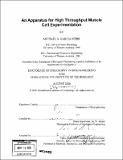An apparatus for high throughput muscle cell experimentation
Author(s)
Garcia-Webb, Michael G. (Michael Gregory)
DownloadFull printable version (53.22Mb)
Other Contributors
Massachusetts Institute of Technology. Biological Engineering Division.
Advisor
Ian W. Hunter.
Terms of use
Metadata
Show full item recordAbstract
The cardiac ventricular muscle cell (myocyte) is a key experimental system for exploring the mechanical properties of the diseased and healthy heart. The myocyte experimental model provides a higher level of physiological relevance than molecular or myofibril studies while avoiding problems inherent to multicellular preparations including heterogeneity of cell types and diffusion limited extracellular spaces. Millions of primary myocytes that remain viable for four to six hours can be readily isolated from animal models. However, the mechanical properties of only a few physically loaded myocytes can be explored in this time period using current, bulky and expensive instrumentation. In this thesis, a prototype instrument is described that is modular and inexpensive and could form the basis of an array of devices for probing the mechanical properties of single mammnalian myocytes in parallel. This would greatly increase the throughput of scientific experimentation and could be applied as a high content screening instrument in the pharmaceutical industry providing information at the level of a critical cellular phenotype, myocyte mechanical properties, for drug development and toxicology studies. (cont.) The design, development and experimental verification of the modular instrument are presented here. The mathematical, mechanical and electrical characteristics of the novel force sensor and actuator system, Ho control implementation and data processing methodology are discussed. Finally, the functionality of the instrument is demonstrated by implementing novel methodologies for loading and attaching healthy, single mammalian ventricular myocytes to the force sensor and actuator and measuring their isometric twitch force and passive dynamic stiffness at varied sarcomere lengths.
Description
Thesis (Ph. D.)--Massachusetts Institute of Technology, Biological Engineering Division, 2006. MIT Science Library copy: printed in pages versus leaves. Also issued in pages. Includes bibliographical references (leaves 183-197).
Date issued
2006Department
Massachusetts Institute of Technology. Department of Biological EngineeringPublisher
Massachusetts Institute of Technology
Keywords
Biological Engineering Division.